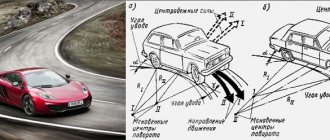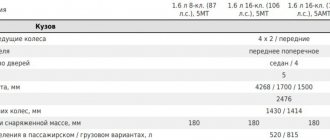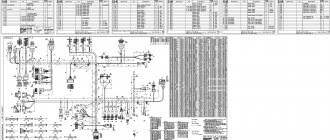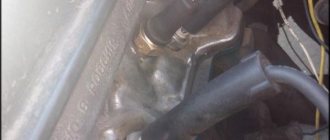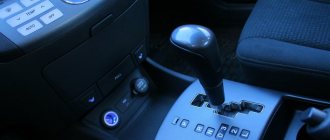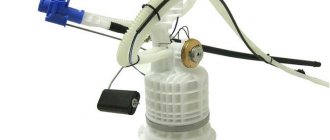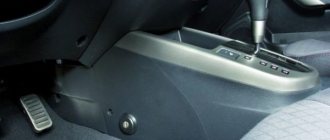An automatic transmission is a widespread car element in the world, but relatively recently it has become popular in Russia. Most domestic cars were previously equipped only with a manual transmission, while foreign cars with manual transmissions in the Russian Federation used to be bought much more often - for their affordable price and familiar controls. Therefore, the culture of driving vehicles with an automatic transmission is just beginning to take shape in the country. Because of this, some drivers, both beginners and those who have previously only used manual transmissions, may have a question about how to properly drive an automatic transmission in the city, in traffic jams, in winter and off-road.
Differences between automatic and manual
For many years, domestic car manufacturers have installed mechanical transmissions on almost all of their products. And you could choose a car with an automatic transmission mainly in the model ranges of American, Japanese and Western European brands. Most Russian motorists had the skills to use only manual transmissions. But the gradually growing demand for vehicles with simplified controls has led to the fact that automatic transmissions are found on domestic cars almost as often as on foreign cars.
A manual transmission is a multi-stage gearbox in which the driver shifts gears manually. The number of speeds is usually in the range of 3–7. The design includes a metal shaft with fixed or rotating gears. Synchronization of pairs of gears leads to their blocking and holding in this position until the driver switches the mechanism to another gear using a single-plate clutch.
The list of the main advantages of manual transmission compared to automatic transmission includes:
- improving driving capabilities;
- reduction of fuel consumption;
- fast acceleration;
- acquiring driving skills that are sufficient to drive a car with an automatic transmission - whereas it is more difficult for a driver who learned to drive a car with an automatic transmission to switch to a manual transmission.
Despite many advantages, manual transmissions have many disadvantages. The driver has to put in more effort, which causes him to get tired faster. Learning to drive with a manual transmission is more difficult and takes longer. There is a risk of overloading the transmission and engine due to an incorrectly selected manual gear. And the switching will not be as smooth as when using an automatic transmission.
Features of automatic transmission
The operating principle of an automatic transmission is based on the transmission of torque using planetary gears and a torque converter. Automatic cars do not have a clutch, making them easier to drive. And automatic selection of the desired gear reduces the risk of overload. But this mechanism also has disadvantages:
- the cost and weight of the car increase;
- fuel consumption increases in all driving modes;
The maximum speed of movement decreases compared to “mechanics”.
The lack of constant communication between the power unit and the drive wheels, as well as the use of a torque converter, leads to a decrease in engine efficiency. But all these disadvantages are compensated by the simplicity of the system and ease of control. Even the automatic transmission handle has only 3 main positions - forward, backward and park. Although a driver who has never driven a car with such a gearbox should still get acquainted with the features of its use.
What is better automatic transmission or manual transmission?
For many years, novice drivers, in an attempt to get an answer to the question of which is better - an automatic transmission or a manual transmission, have only encountered disputes on the Internet, but they cannot get a clear answer. Therefore, it is best to try both options yourself and then have your own opinion about “mechanics” and “automatic”. That's what I did. After 10 years of driving a manual transmission, I switched to a car with an automatic transmission. I share my feelings.
As for the “mechanics”, it allows the driver to exercise maximum control over the movement. He decides when to upshift or downshift. Of course, this requires the driver to make unnecessary movements and expend effort, but, unlike an automatic machine, the driver knows in advance what maneuver he is going to perform. Therefore, he completely controls the position of the car on the road. However, it is worth paying attention to the fact that comfortable driving with a manual transmission is only available to drivers with solid driving experience. It will be easier for beginners to drive an automatic car.
Transmission operating modes - "automatic"
The main automatic transmission modes are drive, neutral, reverse, park, kick-down and overdrive. Separately, it is worth highlighting parking on a slope, which requires additional actions from the driver and differs from regular parking. Some cars may have modes 2, 3, 4, L and Power.
Movement (D or Drive)
The driving mode is the main one for any car with an automatic transmission. Allows you to stop at traffic lights by simply pressing the brake. Some cars have an additional mode “2”, when selected, the car uses only first and second gears, and the speed is limited to 40–60 km/h. It is used on steep roads and descents. And the automatic transmission of SUVs may have an L mode - an analogue of a reduction gear, designed for difficult conditions and speeds of up to 15 km/h.
An important rule when using an automatic transmission is that the driver should not use his other foot. This can lead to accidental pressing of the gas due to the fact that the body moves forward by inertia when braking. To avoid problems, the left foot should be on a stand.
You should know! The peculiarity of using mode D is the need to press the gas only after a slight push. It takes about 1 second to prepare the box for movement. But if you press the pedal too early, the load may be too high and cause damage to the mechanism.
Neutral (N)
The neutral gear mode on cars with automatic transmission is used only when towing or servicing the car at a service center. You should not switch to it while moving downhill - this leads to premature failure of the gearbox. It makes no sense to use the mode when stopping at a traffic light. It is possible to tow a car in neutral gear, but due to the risk of damage to the automatic transmission, it is better to avoid such situations. If there are no other possibilities, it is allowed to transport a car with an automatic transmission over a distance of up to 50 km and at a speed not exceeding 50 km/h.
Important! It is prohibited to use towing to start the engine of a car with an automatic transmission “from the pusher”. The result may be a breakdown of the mechanism - just like trying to tow a car through snow or sand.
Reverse (R)
When using this mode, the brake is pressed and the automatic transmission handle is moved to position R. This should not be done until the car is completely stopped, as this can lead to damage to the gearbox and other elements of the vehicle transmission. This type of error is often made by novice drivers when they are about to park and switch the selector from D to R before the car has completely stopped moving.
Parking (P)
A mode that, when selected, first blocks the output shaft of the automatic machine, and then the drive wheels. And you should choose it during a long stop or when parking the car. Some drivers use P mode even if they stand at a traffic light for a long time.
You should know! The mode must be turned on only when the vehicle is completely stopped to avoid damage to the transmission. Shifting from P to R or D is performed while the brake is depressed.
Parking on a slope in parking mode
But, if the angle of inclination of the platform on which the car with automatic transmission is installed is significant, you will have to use not only the parking mode, but also the handbrake. To do this, the driver must first press the normal brake and then apply the parking brake. Now you can release the pedal and select position P. When switching to normal mode, the selector is moved to D, the brake is pressed, and the handbrake is lowered.
Important! By placing a car with an automatic transmission on a slope without using the parking brake, the driver increases the load on the gearbox. Because of this, the locking gear quickly wears out and fails. And when you try to use the parking mode, the car will roll away.
Overdrive (Over Drive or OD)
The Overdrive mode button is by default recessed into the levers of automatic transmissions that have more than three gears - that is, all modern models. With its help, the transition to the highest speeds is carried out, starting from the fourth. To disable the mode (after which the O/D OFF indicator lights up), just turn off the button. This will lead to the impossibility of selecting a gear higher than third even with an increase in engine speed. Disabled overdrive is well suited for long climbs, increasing the traction of the power unit, and soft braking.
You should know! It is not recommended to disable the overdrive mode when the vehicle speed is above 90–120 km/h. This may damage the transmission.
Kick down
In new car models, when you press the gas sharply, the automatic transmission by default activates the kick-down mode, shifting to a lower gear. In older cars, you have to press the pedal and then quickly release it. The mode provides intense acceleration at high engine speeds. And it can come in handy during maneuvering and in extreme situations, when you need to accelerate sharply or avoid a collision.
Important! Kick-down increases the load on the automatic transmission, and it is not recommended to use it too often. Especially for fun or to get away quickly at speeds up to 20 km/h.
Power (PWR or Sport)
An automatic transmission mode designed to be considered “sporty” and allowing you to change gears at higher speeds. It has high fuel consumption, but improves dynamics. Due to the severe wear of the gearbox in this mode, it is not recommended to constantly use Power. But with its help you can easily accelerate the car, immediately moving to second gear and reducing the likelihood of slipping in the snow. The risk of slipping in other conditions is also reduced due to the fact that gears will change in a narrow speed range.
You should know! On some cars, including Toyota models, the Power button is also used to switch to another mode with a similar operating principle - Snow. It is recommended to use it when traveling in snow. But some drivers argue that turning on Snow constantly can reduce gasoline consumption. True, such savings will be rational only in winter, and in summer the absence of first gear leads to overheating and rapid failure of the gearbox.
How to use an automatic transmission
The automatic selector lever can be located not only in the place of a conventional mechanical lever. You can find it under the steering wheel. In addition to standard programs, the automatic transmission has additional modes.
Read
Automatic transmission reset, calibration and adaptation
Before I give advice on how to use the machine, you need to understand what modes there are on the box and what they are responsible for.
Automatic transmission modes
The automatic transmission has the following gear shift positions:
- “P” – parking. (Not for mechanics) You must set the rocker to this position when parked in a parking lot or near the house. Start and stop the engine only in this mode. I do not recommend setting the rocker in this position until the car has completely stopped;
- “R” – backward movement. (Available for mechanics) You turn on this mode when you want to start moving backwards to get out of a parking lot or to free up space, and there is a wall or a car ahead. I do not recommend switching the rocker to this position while the car is moving;
- “N” – neutral position. (Available for mechanics) Turn on this mode only when the vehicle is being towed;
- "D" - forward movement. (No on manuals) You switch the rocker to this mode when you want to go forward. The machine independently switches speeds, which are displayed on the gear panel monitor;
- “L” – low gear. (Not on mechanics) Manual mode. The car will always move at first speed. I recommend using it when driving off-road at a speed of no more than 15 km/h.
Read
Design and principle of operation of a hydromechanical gearbox
These are the main modes of the machine. Some of them are identical with mechanics. But there are also additional modes that can be activated using buttons or steering wheel paddles. And some others, for example, the “Kick Down” mode.
But these modes relate more to the functions of the machine.
Functions and number of pedals
Let's talk about functions, but first let's touch on the number of pedals. There are only two of them, unlike mechanics. These are “Gas” and “Brake”.
There is no third pedal, like on a manual, which is responsible for the clutch. For those who are new to an automatic after driving a manual transmission, the lack of a clutch pedal is difficult to grasp.
Therefore, you may accidentally hit the brake with your left foot while accelerating the car. To prevent this from happening, place your foot in a special place, which is located to the left of the driver next to the door. It is made in the form of a pedal. This way you will protect yourself from accidentally pressing the brake on an automatic transmission.
Another problem for those who switched from manual to automatic is the kickdown mode. Again, the driver sets this procedure to the gearbox when he intuitively believes that it is necessary to change gears, as in a manual transmission. The driver's brain sends a signal to the right foot to press the accelerator, as if he had already changed gears and depressed the clutch pedal. And his foot is already on the gas, so he presses the accelerator even harder to the floor, like on a manual transmission.
Read
Reasons for automatic transmission going into emergency mode and ways to reset the error
A function called “Kickdown” is launched. The car begins to accelerate powerfully by automatically downshifting two gears.
Attention! The incidents described above should not happen to you on the highway, as you are creating an emergency situation.
Now let's look at the functions that make the work of the driver and automatic transmission easier, increasing service life:
- “Sport” (No manual) is a mode that can be used when driving on the motorway. Fuel consumption increases, but the car moves at high speed. This allows you to cover long distances in a short time;
- “Snow” (Not on mechanics) – most often displayed as a snowflake drawn on the button. This is winter mode. It needs to be turned on when you are driving on a slippery road or starting to drive in the snow. Increases wheel grip on the surface due to the fact that the car starts moving immediately from second gear;
- “1”, “2”, “3”, “M” (No for mechanics) – imitation of mechanics. Allows you to move only in one of the selected gears. These modes can be used when driving on dirt roads, rocky or hilly terrain.
We figured out the automatic modes and functions. Now let's look at the control features. They are slightly different from the controls on the mechanics. For example, you cannot start moving backwards without first stopping the vehicle. But first things first.
Read
Features of operation and maintenance of automatic transmission
Rules for driving a car with automatic transmission
The question of how to drive an automatic transmission often arises among drivers who previously only used cars with manual transmission. It is more difficult for them to get used to the fact that they need to use only one leg to control, placing the second one on a stand. Moreover, taking a habitual position for a car with a manual transmission can increase the risk of an accident. After all, if one foot is on the gas and the other on the brake, when braking, the force of inertia often leads to involuntary pressing of the left pedal. And instead of stopping, the car can, on the contrary, start moving.
Standing start
You should only start driving a car with an automatic transmission by starting and warming up the engine with the selector lever set to position N or P (the second option is recommended by car manufacturers). If the outside temperature is positive, it is enough to wait about 2 minutes. This is enough to evenly distribute the lubricant and get the box into operating mode. If the temperature is below zero, the power unit has to be warmed up much longer - in severe frost, at least 10 minutes.
If you find problems with starting the engine, you should make sure that the gear lever is positioned correctly. When the engine has warmed up, you should select the desired driving mode by switching the lever and waiting for a slight push. If you start moving earlier, the risk of automatic transmission failure increases.
Braking
Drivers who have learned to drive a manual transmission may have problems not only with starting to move, but also with braking. To avoid mistakes, you should follow certain rules when pressing the brake. To stop at traffic lights and crossings, simply press the pedal. If the driver expects that the stop will be long (the car is stuck in a traffic jam or the timer shows that the red light will be on for at least a minute), switches to P mode. This will allow the right leg to rest a little while parking.
Using the parking brake
The handbrake allows you to avoid accidental forward movement and the creation of an emergency situation. In accordance with the vehicle operating instructions, the parking brake should be applied during any long stop. The handbrake should also be used if the driver does not turn off the engine, the car has slowed down on a slope or stopped to change wheels.
Towing a car with automatic transmission
You can tow a car with an automatic transmission, but you must comply with a number of requirements:
- the engine must be started and mode N must be selected on the automatic transmission;
- towing distance – no more than 50 km;
- The maximum speed of moving a car in this way is 50 km/h.
If the engine fails to start or the distance is greater than recommended, it will be easier to call a tow truck. Paying for his services will cost less than repairing a broken gearbox. It is also worth remembering that the weight of the towing vehicle must be no less than that of the towed one.
Starting to move in tow
There is no exact algorithm for starting the engine of a towed vehicle. But one of the most popular methods involves doing the following:
- Engage neutral gear.
- Turn on the ignition and start driving in tow. In a car with a warm transmission, you should drive at a speed of about 50 km/h, with a cold transmission - up to 30 km/h.
- Drive for 2 minutes - this is how long it will take to achieve the required lubricant pressure.
- Move the selector to position 2 or L.
- Press on the gas and return to neutral after starting the engine.
If the engine does not start a few seconds after pressing the gas pedal, this attempt should not be repeated. To prevent the gearbox from overheating, set the selector to position N. And after 2 minutes, perform steps 4 and 5 again.
Control Features
For those who often change from manual to automatic and vice versa, it will no longer be difficult to move away and park. But for new drivers this is difficult to do. I will give instructions on how to drive a car with an automatic transmission.
How to start with an automatic transmission
To drive a manual transmission, you need to constantly press the clutch, shift the manual transmission, then press the accelerator. There is no need to do this on an automatic transmission. The main thing is to know the rules of sequential control of the machine so as not to break it.
- You can start the car only with the gear shifter in the “Parking” mode. Therefore, if the lever is in this position, we do not touch it.
- Turn on the ignition. We press the brake pedal and move the automatic transmission lever to position “D” if we want to go forward or “R” if we want to go backward.
- Depress the brake pedal. The car starts moving.
If you do not press the brake while changing gears, the car may roll. This should not be allowed in a parking lot, where you can crash into any nearby car.
Remember to change gears correctly, especially with automatic transmissions. Otherwise, you may damage the device.
Braking
Car owners who have switched from manual to automatic try to switch the gearbox lever to the “P” position when braking. This is not required of you. If you are stopping at a traffic light for a short time, all you need to do is press the brake pedal.
Read
Types of automatic transmission blockers
If you are in a traffic jam and understand that the stop will drag on for an indefinite period of time, move the rocker to the “N” or neutral position.
Reverse
Reverse is performed only after the vehicle has come to a complete stop. You move the selector lever from position “D” to mode “R”. You take your foot off the brake pedal and slowly press the accelerator, looking in the rear-view mirrors so as not to fit into some car, and start driving the car backwards.
Then press the brakes again, move the selector knob to position “D” and move forward, or turn off the ignition, remembering to move the automatic lever to “P”.
Parking
After parking, be sure to apply the handbrake. It will protect the car from machine breakdown. Because if the automatic transmission is under constant tension, especially when standing on a slope without a handbrake, then the teeth of the gear that keeps the wheels from moving may break.
Read more about parking for beginners here.
Use in the city and on the highway
If the driver has never driven a car with an automatic transmission before, he will have to spend time adapting and not making mistakes. Such as automatically switching the handle to the wrong position or accidentally pressing the brake or gas pedal instead of the missing clutch. To quickly understand and start using a car with an automatic transmission, it is worth getting acquainted with the theory of movement on such vehicles.
When driving around the city in a car with automatic transmission, the mode is selected depending on the road conditions. For this purpose, modes 1, 2 and 3 are used, which can be compared to manual transmissions. At low speeds, up to 25 km/h, you should choose the first stage - this option is great for driving in traffic jams. At 40–50 km/h, if necessary, move slowly - second. The third stage or D mode is selected when the speed reaches 60 km/h.
The same principle should be followed when traveling on country roads. Selecting mode D provides a car with an automatic transmission with better dynamics and minimal load on the gearbox and engine. Mode 1 is suitable for slow off-road driving, and mode 2 is suitable for forests or mountain serpentine roads.
Driving a car with automatic transmission in the cold season
After parking overnight in the cold season, the engine may start worse. Modern fuel injection systems avoid such problems by dispensing with warm-up before starting the trip. But to increase the service life of the internal combustion engine, it is better to perform a few simple steps:
- Start the engine, allowing it to run for some time without load, sufficient to dilute the oil and fill the entire lubrication system with it, heating the cylinders and pistons.
- After 2-3 minutes, press the brake and move the handle to the Drive position.
- After waiting 20-30 seconds, switch to reverse mode (R).
- After half a minute, repeat the procedure of switching to mode D and returning to R 1-2 times, tightening the handbrake and lightly pressing the gas. At this point, warming up the engine is considered complete, and you can begin the trip.
The main advantage of a hydromechanical transmission is the smooth movement of the car, without the jerks that can be encountered when using a manual transmission. On a manual car, a soft start will only be achieved by experienced drivers using a new, unworn clutch.
If the automatic transmission has the ability to forcibly switch to the first and second stages, you should definitely use it:
- For the first 400–600 m, select mode 1.
- Set to position 2, maintaining engine speed at 2000 rpm.
- Switch to automatic mode.
- Continue driving, gently pressing the gas. After about 10 km, the automatic transmission goes into normal mode and can change the gear ratio without driver intervention.
It takes little time to warm up the automatic transmission and the engine, and the result is an increase in the operating efficiency and service life of both the engine and the hydromechanical transmission. But, if you can repair the engine in almost any car service center, not all specialists will undertake the repair of the automatic machine, the price will be high, and a positive result is not guaranteed.
Several features of traveling in winter
For a car with automatic transmission in winter, you should follow certain rules:
- You should move smoothly on winter roads, without sudden braking or strong acceleration;
- a greater distance must be maintained between cars than in the summer - this compensates for the reduction in braking distance;
- tires on cars - only winter ones, not necessarily with studs, but with a tread suitable for such conditions;
- if the traction of the wheels and the snowy road deteriorate, you should switch to manual control of the “automatic”, turning on mode 2 or 3 to reduce the risk of wheel slipping;
- if the automatic transmission has a “Winter” or Snow mode, you should choose it;
- when driving through sharp turns, you should brake in advance, allowing the automatic transmission to switch to a lower gear, or forcefully select mode 2 or 3 in advance;
- When turning, it is worth accelerating a little, increasing the grip of the drive wheels with the road.
When driving in difficult conditions, on snow or ice, if it is not possible to maintain the required distance, you should drive by selecting second or third gear. This will improve the vehicle's braking performance in dangerous situations.
Automatic problems in winter
In the cold season, the owner of a car with automatic transmission may encounter certain problems. But each has its own fairly effective solution. So, if one wheel slides on the ice and the other is stationary, the car will not be able to move - and constantly pressing the gas will only increase the load on the gearbox. The solution to the problem is to add sand or salt under each wheel, a supply of which should be carried in the trunk in winter.
If the car gets stuck when leaving a snowdrift, you should turn off the ESP stability control system and try to rock the car, alternately switching to modes D and R. At the same time, you should switch the handle and press the brake, releasing the pedal after a slight push appears. If your car gets stuck in the snow, you should take care of the transmission and take the help of other road users, call a tow truck or a tow truck.
It is better not to tow faulty cars with automatic transmission in winter and at other times of the year, but to evacuate them to a repair site. If you still choose a tug, you must follow the 50/50 rule – speed up to 50 km/h, distance no more than 50 km. When towing, the selector is set to position N.
A special feature of using a hydromechanical transmission in difficult conditions, including driving on loose snow and steep climbs, is the high probability of wheel slipping. It is connected with the lack of a rigid connection between the engine and the automatic transmission. And in such a situation, the driver must engage a lower gear in time.
How to use automatic transmission
Now is the time to learn how to drive an automatic car.
- To do this, you need to learn one simple rule - any change in the position of the selector must be made when the car is completely stopped and the brake pedal is depressed . Otherwise, you risk ruining the automatic transmission ahead of schedule.
- Always check the oil level before a long trip . The fact is that it not only performs lubricating functions, but also cools the entire assembly. When the engine starts, the oil pump is activated, which causes the fluid inside the box to circulate. Therefore, without it, you can not only overheat it, but also accelerate the wear of the gears.
- Before starting the engine, depress the brake and move the selector to the neutral position . After this, turn on the starter and let the box warm up for a while. Then turn on mode D and start moving smoothly, releasing the brake and then adding gas. When stopping, move the selector to the neutral position.
- The last thing I would like to pay attention to is towing . In case of any malfunction, it is advisable to call a tow truck. The fact is that when towing, the oil pump does not work and the transmission overheats, so the manufacturer recommends doing this over distances of no more than 30-40 kilometers with periodic stops to cool the unit. If you are the owner of an all-wheel drive car, then in this case you will definitely need to remove the driveshaft.


